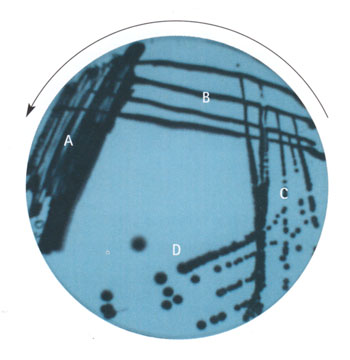Making a streak plate
Notes based on information in 'Basic practical microbiology' © Society for General Microbiology.
Refer to Aseptic techniques before starting this or any other microbiology practical work.
You can make streak plates of bacteria or yeasts. A streak plate involves the progressive dilution of an inoculum of bacteria or yeast over the surface of solidified agar medium in a Petri dish. The result is that some of the colonies on the plate grow well separated from each other. The aim of the procedure is to obtain single isolated pure colonies. If more than one shape or colour of colony on the streak lines is evident, this indicates that a culture contains more than one type or species of bacterium or yeast. This method is the most straightforward of the various methods for preparing a streak plate. See Note 1 for alternatives.
This technique is used to check the purity of cultures that are being maintained over a long period of time – regular sampling and streaking will show any contamination by other microbes. It is also used by expert practitioners to start new maintained cultures by picking off an appropriate isolated colony of an identifiable species with a sterile loop and growing the cells in sterile nutrient broth.
Health & Safety and technical notes
1 Two other approaches when making a streak plate are:
i to lift the lid vertically (i.e. still directly above the base) the least amount that will allow access of the loop
ii to place the lid on the working surface, lift out the base, invert it and inoculate the upwards-facing agar surface. This is the method used by professional microbiologists and is best reserved for older students working in a relatively dust and draught-free laboratory.
2 You could photocopy and cut out a simple drawing of where the streaks should be and fix it temporarily to the agar plate as a template – making it easier to put the streaks in the right place.
Procedure
a Loosen the cap of the bottle containing the inoculum.
b Hold an inoculation loop in your right hand.
c Flame the loop and allow it to cool.
d Lift the bottle/ test tube containing the inoculum with your left hand.
e Remove the cap/ cotton wool plug of the bottle/ test tube with the little finger of your right hand.
f Flame the neck of the bottle/ test tube.
g Insert the loop into the culture broth and withdraw. At all times hold the loop as still as possible.
h Flame the neck of the bottle/ test tube again.
i Replace the cap/ cotton wool plug of the bottle/ test tube using the little finger of your right hand. Place the bottle/ test tube on the bench (or in a rack).
j Partially lift the lid of the Petri dish containing the solid medium.
k Hold the charged loop parallel to the surface of the agar. Smear the inoculum backwards and forwards across a small area of the medium (see streaked area ‘A’ in the photograph).
l Remove the loop and close the Petri dish.
m Flame the loop again and allow it to cool.
n Turn the dish through 90° anticlockwise.
o With the cooled loop, streak the plate from area ‘A’ across the surface of the agar in three or four parallel lines (area ‘B’). Make sure that a small amount of the culture is carried over.

p Remove the loop and close the Petri dish.
q Flame the loop again and allow it to cool. Turn the dish through 90° anticlockwise again and streak from ‘B’ across the surface of the agar in three or four parallel lines (area ‘C’).
r Remove the loop and close the Petri dish.
s Flame the loop again and allow to cool. Turn the dish through 90° anticlockwise and streak the loop across the surface of the agar from ‘C’ into the centre of the plate ‘D’.
t Remove the loop and close the Petri dish. Flame the loop again.
u Tape the plate closed and incubate the plate in an inverted position.
Web links
Microbiology teacher resources
Society for General Microbiology – source of Basic Practical Microbiology, an excellent manual of laboratory techniques and Practical Microbiology for Secondary Schools, a selection of tried and tested practicals using microorganisms.
Microbiology online
MiSAC (Microbiology in Schools Advisory Committee) is supported by the Society for General Microbiology (see above) and their websites include more safety information and a link to ask for advice by email.
(Websites accessed October 2011)


